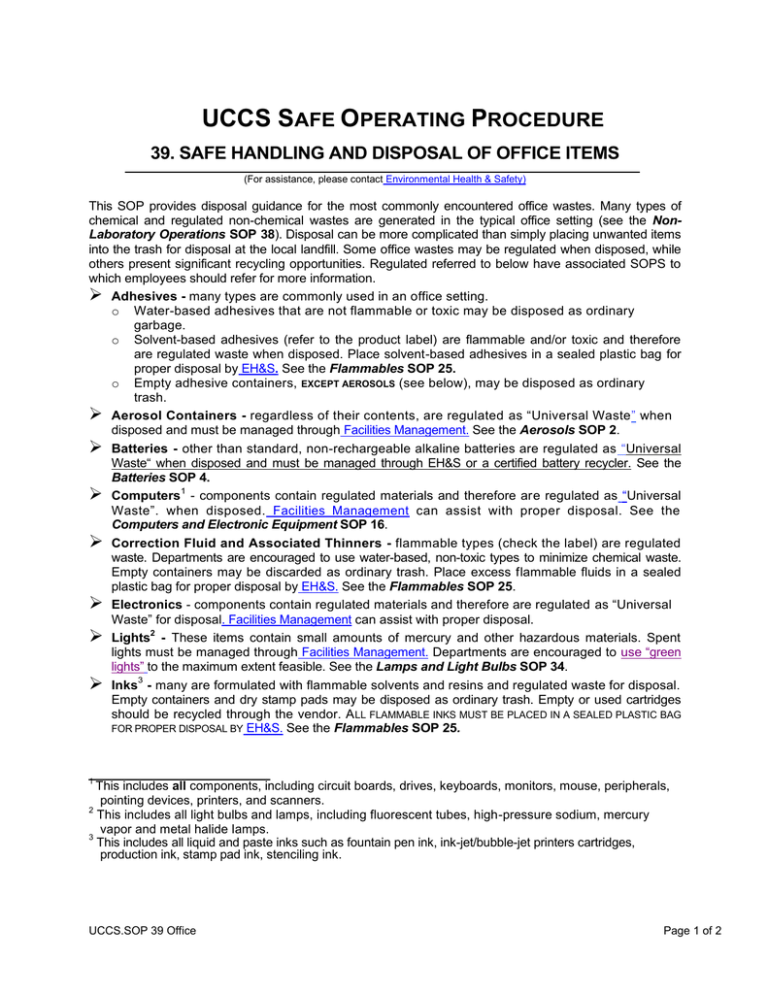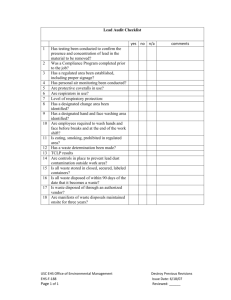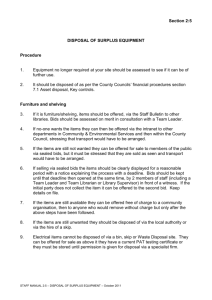UCCS S O P
advertisement

UCCS SAFE OPERATING PROCEDURE 39. SAFE HANDLING AND DISPOSAL OF OFFICE ITEMS (For assistance, please contact Environmental Health & Safety) This SOP provides disposal guidance for the most commonly encountered office wastes. Many types of chemical and regulated non-chemical wastes are generated in the typical office setting (see the NonLaboratory Operations SOP 38). Disposal can be more complicated than simply placing unwanted items into the trash for disposal at the local landfill. Some office wastes may be regulated when disposed, while others present significant recycling opportunities. Regulated referred to below have associated SOPS to which employees should refer for more information. Adhesives - many types are commonly used in an office setting. o Water-based adhesives that are not flammable or toxic may be disposed as ordinary garbage. o Solvent-based adhesives (refer to the product label) are flammable and/or toxic and therefore are regulated waste when disposed. Place solvent-based adhesives in a sealed plastic bag for proper disposal by EH&S. See the Flammables SOP 25. o Empty adhesive containers, EXCEPT AEROSOLS (see below), may be disposed as ordinary trash. Aerosol Containers - regardless of their contents, are regulated as “Universal Waste” when disposed and must be managed through Facilities Management. See the Aerosols SOP 2. Batteries - other than standard, non-rechargeable alkaline batteries are regulated as “Universal Waste“ when disposed and must be managed through EH&S or a certified battery recycler. See the Batteries SOP 4. Computers1 - components contain regulated materials and therefore are regulated as “Universal Waste”. when disposed. Facilities Management can assist with proper disposal. See the Computers and Electronic Equipment SOP 16. Correction Fluid and Associated Thinners - flammable types (check the label) are regulated waste. Departments are encouraged to use water-based, non-toxic types to minimize chemical waste. Empty containers may be discarded as ordinary trash. Place excess flammable fluids in a sealed plastic bag for proper disposal by EH&S. See the Flammables SOP 25. Electronics - components contain regulated materials and therefore are regulated as “Universal Waste” for disposal. Facilities Management can assist with proper disposal. Lights2 - These items contain small amounts of mercury and other hazardous materials. Spent lights must be managed through Facilities Management. Departments are encouraged to use “green lights” to the maximum extent feasible. See the Lamps and Light Bulbs SOP 34. Inks3 - many are formulated with flammable solvents and resins and regulated waste for disposal. Empty containers and dry stamp pads may be disposed as ordinary trash. Empty or used cartridges should be recycled through the vendor. A LL FLAMMABLE INKS MUST BE PLACED IN A SEALED PLASTIC BAG FOR PROPER DISPOSAL BY EH&S. See the Flammables SOP 25. 1 This includes all components, including circuit boards, drives, keyboards, monitors, mouse, peripherals, pointing devices, printers, and scanners. 2 This includes all light bulbs and lamps, including fluorescent tubes, high-pressure sodium, mercury vapor and metal halide lamps. 3 This includes all liquid and paste inks such as fountain pen ink, ink-jet/bubble-jet printers cartridges, production ink, stamp pad ink, stenciling ink. UCCS.SOP 39 Office Page 1 of 2 4 Media (CD’s, diskettes, video, and audiotapes) - may be discarded as ordinary trash, unless the media is constructed of nitrocellulose. Nitrocellulose films or tapes are regulated waste and must be placed in a sealed plastic bag for proper disposal by EH&S Paints - Latex or water-based paints THAT ARE COMPLETELY DRIED can be disposed as ordinary trash. Oil based or flammable paints and solvents are regulated waste, contact EH&S for proper disposal. See the Paint and Paint-Related Materials SOP 42. Paper - most types of paper are suitable for recycling: phone books, newspaper, white & colored stationery paper, NCR paper, copy paper, ledger paper, white computer paper, red or green bar computer paper, tablet paper (any color), envelopes (without windows—however, the window can be ripped out and the remainder of the envelope recycled), file folders, ream wrappers, and card stock. THE FOLLOWING TYPES OF PAPER ARE NOT SUITABLE FOR RECYCLING: CARBON PAPER, FOOD WRAPPERS, GROCERY BAGS, SLICK FAX PAPER, AND PAPER TOWELS. Contact Facilities Management for additional information and recycling locations. Pens, Pencils, Chalk, etc. - are not regulated and may be disposed as ordinary trash. 4 Sharps (razor blades, tacks, pins, broken glass) - are not regulated (unless contaminated by human blood, see the Handling and Disposal of Biohazardous Materials SOP 5). They should be sealed in a puncture-resistant container (such as a plastic bottle), labeled "Sharps" and disposed as ordinary trash. See the Sharps SOP 50. Toner Cartridges - Dry toner and empty toner cartridges are not generally regulated for disposal. However, these items should be sealed in heavy plastic bags before being placed in the garbage to protect custodial workers from the fine particulate dust. Departments are encouraged to participate in a cartridge-recycling program (empty cartridges are returned to vendors for refilling). Even when non-infectious, broken glass, needles, knives, razor blades and other “sharps” can be hazardous to persons handling trash. For this reason, if at all possible, turn “sharps” over to a facility with appropriate sharps disposal containers (Student Health Clinic, Beth-El College of Nursing and Health Science, Biology). Last reviewed by Cynthia Norton on December 14, 2015. UCCS.SOP 39 Office Page 2 of 2



